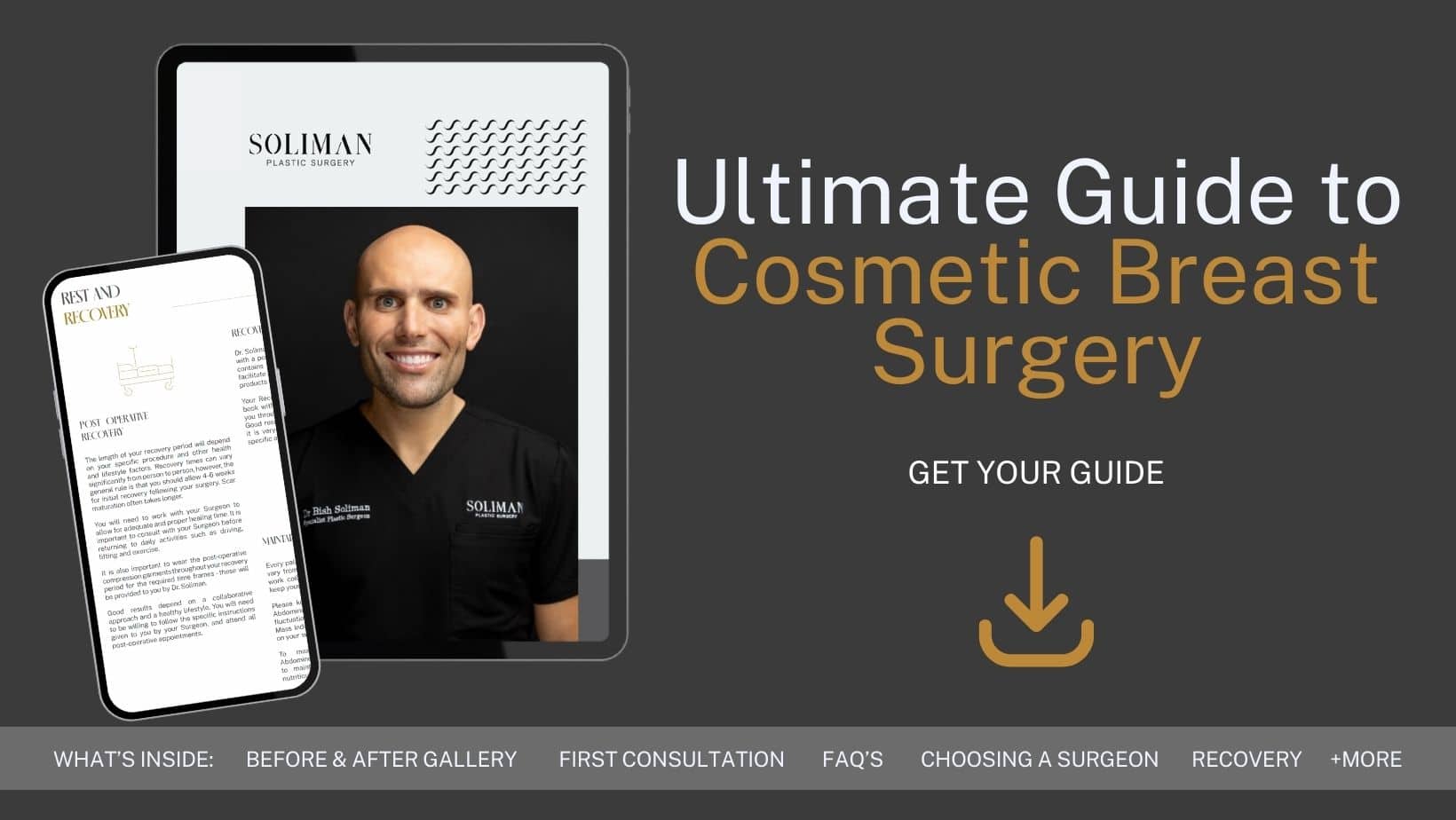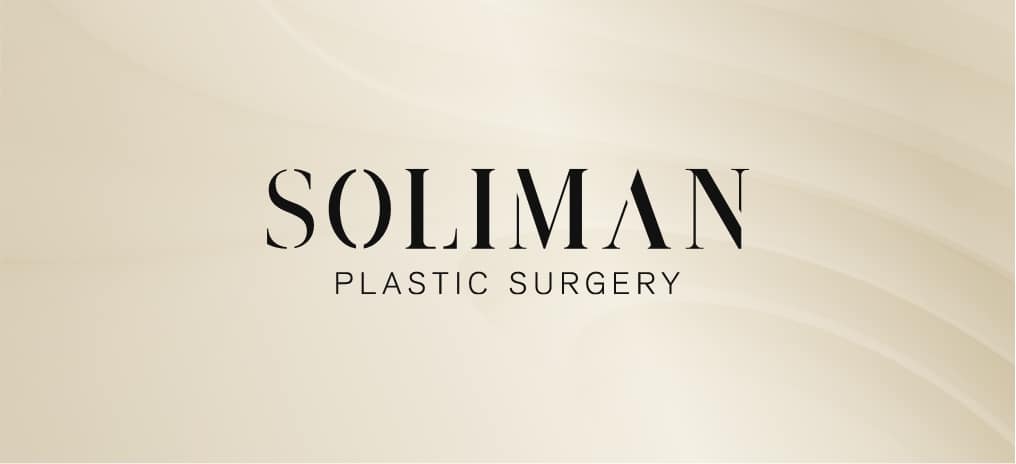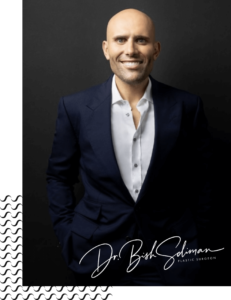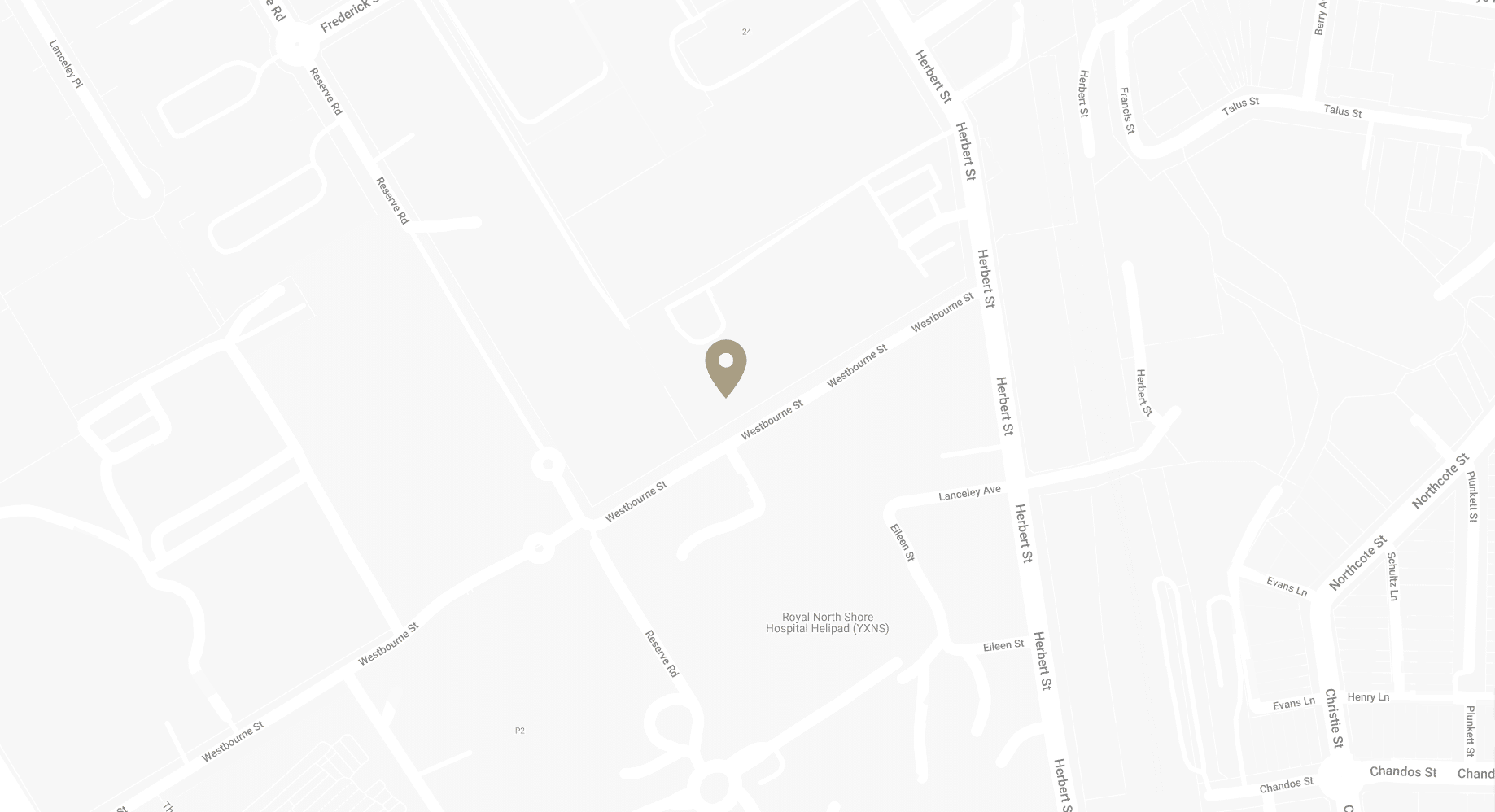Everything You Need to Know about Silicone Breast Implants
In the world of aesthetic surgery, breast augmentation remains one of the most sought-after procedures. But before you proceed, it’s vital to understand the different types of breast implants, specifically silicone breast implants, and what they entail.
Breast implants have evolved significantly over the years. They are designed to increase the size and fullness of the breasts. This blog can serve as your guide to understanding the types of implants, with a particular focus on silicone breast implants. You will learn about their benefits, the process of getting them, potential risks and complications, and how they compare with other types of implants. This blog is meant to inform and help you make a well-informed decision.
Sydney Plastic Surgeon Dr Bish Soliman performs breast augmentation with different types of breast implants.
Download Dr Bish Soliman Cosmetic Breast Surgery Guide

What Are Silicone Breast Implants?
Silicone breast implants consist of a silicone outer shell filled with a silicone gel. These implants are known for their natural feel, closely resembling real breast tissue. They come in different sizes, and they can either be smooth or textured. Silicone breast implants are pre-filled before surgery (during manufacturing) and then inserted.
Since their inception in the 1960s, silicone breast implants have undergone various improvements to enhance safety and aesthetic result. Today’s silicone implants are much safer and offer a more natural look and feel than their predecessors.
Silicone breast implants are TGA-approved and widely used worldwide. They are indeed a popular choice for many women seeking breast enlargement procedures.
Benefits of Silicone Breast Implants
One of the primary benefits of silicone breast implants is their realistic feel. They mimic the feel of natural breast tissue better than other types of implants. This is due to the silicone gel inside the implant, which has a similar consistency to natural breast tissue.
Silicone breast implants also offer a natural appearance. They are less likely to cause rippling, a condition where waves or ripples appear under the skin.
Another advantage is their durability. Silicone breast implants are designed to last and retain their shape and size for a long time. Although they can rupture, the silicone tends to remain within the shell or scar tissue, reducing the risk of noticeable leakage.
Types of Silicone Breast Implants
In the contemporary era, individuals seeking breast augmentation have a variety of silicone breast implant options to choose from, each designed to suit different preferences and anatomical considerations. Below we discuss the different types of silicone breast implants available in the market today:
· Round Breast Implants
Round silicone implants are characterised by their spherical shape, which is designed to offer a fuller appearance in the upper portion of the breast. This type of implant is renowned for providing a pronounced, rounder look. The round implants are a popular choice for those looking to achieve a more voluptuous bust line, as they add considerable fullness and volume.
· Anatomical Implants (Teardrop Implants)
Anatomical or ‘teardrop’ implants stand as a contrast to round implants, boasting a shape that more closely resembles a natural breast, with a fuller bottom and a tapered top. This design aims to offer a more subtle and natural-looking enhancement, aligning with the natural contours of the breast. The teardrop implants are ideal for individuals seeking a moderate increase in breast size while maintaining a natural aesthetic. They are known for their ability to offer a gentle lift, enhancing the breast’s shape, as well as its size.
· Gummy Bear Implants
The ‘gummy bear’ implants are the newest addition to the silicone breast implant family. These implants are form-stable, meaning they retain their shape even if the outer shell is broken, thanks to the thicker silicone gel that fills them. This type of implant is named ‘gummy bear’ because the consistency of the silicone gel inside is somewhat similar to that of gummy bear candies, being firm yet pliable. The gummy bear implants offer a firmer feel compared to other types, reducing the risk of rupture and providing a safer option for breast augmentation. Moreover, they are praised for offering a natural feel and a well-defined shape, enhancing the breast’s appearance while minimising potential complications.
The Process of Getting Silicone Breast Implants
The process of getting silicone breast implants involves several steps. First, you will have 2 consultations with Dr Bish Soliman. During these meetings, you will discuss your aesthetic goals, medical history, and the various options available to you.
Next, you will schedule your surgery. The procedure involves making an incision under the breast at the fold. A dual-plane pocket is then created to allow the implant to sit under the pectoralis muscle in the upper half of the breast and under the breast gland in the lower half. Dr Bish will then insert the implant and position it correctly before closing the incision.
After the surgery, there will be a recovery period. You may experience some discomfort, swelling, and bruising, which will gradually subside. It may take several weeks to fully recover, and you will have follow-up appointments with Dr Bish to ensure everything is healing properly.
Risks and Complications of Silicone Breast Implants
Like any surgical procedure, there are risks and potential complications associated with silicone breast implants. These can include infection, bleeding, changes in nipple or breast sensation, and implant leakage or rupture.
Another potential complication is capsular contracture, a condition where scar tissue forms around the implant, causing it to harden and potentially become painful.
While these risks are relatively rare, it’s crucial to discuss them with Dr Bish Soliman before deciding to proceed with the surgery. Understanding these potential complications will help you make an informed decision.
Silicone Breast Implants vs Other Types of Breast Implants
When comparing silicone breast implants with other types, such as saline or composite implants, there are several factors to consider. Each type of implant has its pros and cons, and the right choice for you will depend on your individual needs and preferences.
Saline implants, for example, are filled with sterile salt water. They are inserted empty and then filled once they are in place. While they can offer a uniform shape and firmness, they may not feel as natural as silicone implants.
Composite implants, on the other hand, can be filled with substances like soy oil or polypropylene string. However, these are not as commonly used and may not be approved in all countries.
How to Choose the Best Type of Breast Implant for You
Choosing the best type of breast implant for you is a personal decision that should be made in consultation with Dr Bish Soliman. You should consider your body type, lifestyle, health, and personal preferences.
It’s crucial to consider the look and feel you want to achieve. Silicone breast implants are often recommended for their natural feel and appearance. However, other types of implants may be suitable depending on your unique needs.
FAQs about Silicone Breast Implants
Are silicone breast implants safe?
- Silicone breast implants have undergone rigorous testing and have been extensively studied for safety. The TGA has approved them as safe for breast augmentation and reconstruction surgeries. However, they come with their set of risks and complications, just like any other surgical procedure. Some of the potential risks include infection, implant rupture, and scarring. There is also a rare association with a type of cancer called anaplastic large cell lymphoma (ALCL) which is associated with textured breast implants. It is crucial to be aware of these risks and to have a detailed discussion with Dr Bish Soliman to understand the potential risks and benefits fully. Regular monitoring through self-exams and medical check-ups can help in early detection of any issues.
How long do silicone breast implants last?
- Silicone breast implants are a device and are not designed to last a lifetime. On average, they have a lifespan of 10 to 20 years, although this can vary based on individual circumstances and the quality of the surgery performed. Factors such as ageing, changes in weight, and hormonal fluctuations can affect the longevity of the implants. It is recommended to have regular follow-ups with Dr Bish to monitor the condition of the implants and to ensure they are functioning correctly. Some individuals may find that their implants last longer, while others might face complications earlier.
Can silicone breast implants rupture?
- Yes, silicone breast implants can rupture, although modern implants are designed with highly cohesive gel and durable shells to minimise this risk. In the case of a rupture, the silicone gel might remain within the implant shell or escape into the breast implant pocket, a situation referred to as silicone gel bleed. Symptoms of a rupture can include changes in breast shape, size, or appearance, pain, or swelling. It is often recommended to remove or replace a ruptured implant to prevent further complications. An MRI is the most accurate method to detect a rupture.
What is capsular contracture?
- Capsular contracture is a potential complication that can occur after breast augmentation. It happens when the scar tissue that forms around the implant tightens, causing the breast to feel hard and possibly altering its appearance and causing discomfort. The severity of capsular contracture can vary, and in severe cases, it might require surgery to remove the scar tissue and replace the implant. It is categorised into four grades, with grade four being the most severe, characterised by significant pain and distortion.
Can I breastfeed with silicone breast implants?
- Many individuals can successfully breastfeed after receiving silicone breast implants. However, it largely depends on the type of surgery performed, including the incision site and whether any ducts were severed during the procedure. It is essential to discuss your plans for future breastfeeding with Dr Bish before the surgery. Some individuals might experience decreased milk production, but many can breastfeed without issues.
Will silicone breast implants affect mammograms?
- Depending on placement, Breast implants can make mammograms more challenging to perform and interpret because they can obscure some of the breast tissues. It is vital to inform your mammogram technician about your implants so that special techniques, such as additional views or displacement techniques, can be used to get the most accurate results. It might sometimes be recommended to have other imaging tests, such as an MRI or ultrasound, to examine the breast tissue fully.
Can silicone breast implants cause illness?
- While extensive research has not established a proven link between silicone breast implants and systemic illnesses, there have been reports of individuals experiencing a variety of symptoms, collectively referred to as “breast implant illness.” Symptoms can include fatigue, joint pain, memory loss, and others. It is a controversial and not fully understood area, and more research is needed to understand the potential relationship between breast implants and these symptoms.
What is the recovery time after receiving silicone breast implants?
- Recovery time after receiving silicone breast implants can vary based on individual factors and the specifics of the surgery performed. Most individuals can return to light activities within a week or two, following the surgery. But full recovery, including resuming strenuous activities and heavy lifting, might take several weeks. It is essential to adhere to Dr Bish’s advice on resuming activities and to attend all follow-up appointments to monitor your recovery process. It is generally recommended to wear a support bra and to avoid sleeping on your stomach during the initial recovery period to support optimal healing.
Further Reading about Breast Surgery with Dr Bish Soliman
- Read Dr Bish Soliman’s Breast Augmentation Surgery Page
- Read Dr Bish Soliman’s Blog about Recovery after Breast Augmentation
- Read Dr Bish Soliman’s Blog about How To Prepare Yourself for Breast Augmentation Surgery in Sydney
- Read Dr Bish Soliman’s Blog about Does My Breast Implant Have a Warranty?
- Read Dr Bish Soliman’s Blog about Preparing for Breast Implant Removal Surgery
- Read Dr Bish Soliman’s Blog about Recovery after Breast Lift
- Read Dr Bish Soliman’s Blog about How Effective Are Silicone Strips for Plastic Surgery Scars
- Read Dr Bish Soliman’s Blog about the Impact of Breast Implant Rupture on Lymph Nodes
- Read Dr Bish Soliman’s Blog about Potential Breast Implants Complications and How to Avoid Them



